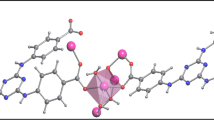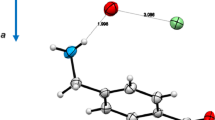Abstract
Three new cadmium(II) coordination compounds \([\hbox {Cd}_{2} (\hbox {L})_{2} (\hbox {btec}) (\hbox {H}_{2} \hbox {O})_{2}] \cdot \hbox {3H}_{2} \hbox {O}\) (1), [Cd(HL)(btb)] (2) and \([\hbox {Cd}(\hbox {L})(\hbox {pda})] \cdot \hbox {2H}_{2} \hbox {O}\) (3) were prepared by hydrothermal reactions of cadmium(II) chloride with ligands L (\(\hbox {L} = \hbox {N}\),\(\hbox {N}^{\prime }\)-bis(3-pyridyl)octandiamide) in the presence of different aromatic polycarboxylates (\(\hbox {H}_{4} \hbox {btec} = \hbox {1,2,4,5-benzenetetracarboxylic acid}\), \(\hbox {H}_{3} \hbox {btb} = \hbox {1,3,5-tri(4-carboxylphenyl)benzene}\), \(\hbox {H}_{2} \hbox {pda} = \hbox {1,4-phenylenediacetic acid}\)). The structures of compounds 1–3 have been determined by X-ray single crystal diffraction analyses and further characterized by infrared spectroscopy (IR), powder X-ray diffraction (PXRD) and thermogravimetric (TG) analyses. Compound 1 displays a 3D metal-organic framework with (4,4,4)-connected \(\{6^{2}.8^{4}\} \{6^{3}.8^{3}\} \{6^{4}.8^{2}\}\) topology constructed from 2D \([\hbox {Cd}_{2} (\hbox {btec})]_{\mathrm{n}}\) layers and \(\mu _{2}\)-bridging L ligands. Compound 2 is a 3D (3,3)-connected \(\{10^{3}\}\) topological network based on the 3D \([\hbox {Cd(btb)}]_{\mathrm{n}}^{\mathrm{n}-}\) framework and the protonated monodentate HL ligand. Compound 3 shows a 2D layer with (3,5)-connected \((4^{2} \cdot 6^{7} \cdot 8)(4^{2} \cdot 6)\) topological structure, which are further linked by hydrogen bonding interactions to form a 3D supramolecular network. The influences of three aromatic polycarboxylates on the structures of title compounds are investigated. Further, the fluorescent properties of three cadmium(II) compounds and their fluorescent sensing properties towards small solvent molecules and metal cations have been studied.
Graphical Abstract
Three new Cd(II) coordination compounds based on the flexible bis(pyridyl)-bis(amide) ligand and three different polycarboxylates have been hydrothermally synthesized. The polycarboxylates with diverse carboxyl groups and various structures play an important role in constructing three Cd(II) compounds. The thermal stabilities, fluorescent and fluorescence sensing properties of the three Cd(II) compounds towards small solvent molecules and metal cations have been reported.







Similar content being viewed by others
References
Suh M P, Park H J, Prasad T K and Lim D W 2012 Hydrogen Storage in Metal–Organic Frameworks Chem. Rev. 112 782
Yoon M, Srirambalaji R and Kim K 2012 Homochiral Metal–Organic Frameworks for Asymmetric Heterogeneous Catalysis Chem. Rev. 112 1196
Lee C H, Wu J Y, Lee G H, Peng S M, Jiang J C and Lu K L 2014 Correlation of Mesh Size of Metal–Carboxylate Layer with Degree of Interpenetration in Pillared-Layer Frameworks Cryst. Growth Des. 14 5608
Lee C H, Wu J Y, Lee G H, Peng S M, Jiang J C and Lu K L 2015 Amide-containing zinc(II) metal–organic layered networks: a structure–\(\text{ CO }_{2}\) capture relationship Inorg. Chem. Front. 2 477
Huang Y J, Pan Y R, Du G and Cao Y X 2016 Extended structures of two coordination polymers based on 1,10-phenanthroline derivatives: Preparation, structural characterization and properties J. Chem. Sci. 128 459
Sutradhar D, Chowdhury H, Koner S, Roy S and Ghosh B K 2016 Two new hexacoordinated coordination polymers of cadmium(II) containing bridging units only: Syntheses, structures and molecular properties J. Chem. Sci. 128 1377
Rajput L, Kim D and Lah M S 2013 Conformational control of ligands to create a finite metal–organic cluster and an extended metal–organic framework CrystEngComm 15 259
Huang S Y, Li J Q, Liu S J, Ning Y, Meng L N, Li J Y, Luo M B and Luo F 2014 Construction and modulation of structural diversity in acylamide-MOFs CrystEngComm 16 5608
Chen M M, Li H X and Lang J P 2016 Two Coordination Polymers and Their Silver(I)-Doped Species: Synthesis, Characterization, and High Catalytic Activity for the Photodegradation of Various Organic Pollutants in Water Eur. J. Inorg. Chem. 2016 2508
Zhang X, Wang Z J, Chen S G, Shi Z Z, Chen J X and Zheng H G 2017 Cd-Based metal–organic frameworks from solvothermal reactions involving in situ aldimine condensation and the highly sensitive detection of \(\text{ Fe }^{3+}\) ions Dalton Trans. 46 2332
Ge F Y, Ma X, Guo D D, Zhu L N, Deng Z P, Huo L H and Gao S 2017 Syntheses, Structural Evolutions, and Properties of Cd(II) Coordination Polymers Induced by Bis(pyridyl) Ligand with Chelated or Protonated Spacer and Diverse Counteranions Cryst. Growth Des. 17 2667
Duan X Y and Wei M L 2017 From One-Dimensional, Two-Dimensional to Three-Dimensional Entangled Architectures with Polythreading Feature: Synthesis, Structures, and Properties Cryst. Growth Des. 17 1197
Hao S Y, Hou S X, Hecke K V and Cui G H 2017 Construction of noninterpenetrating and interpenetrating Co(II) networks with halogenated carboxylate modulated by auxiliary N-donor co-ligands: structural diversity, electrochemical and photocatalytic properties Dalton Trans. 46 1951
Zhang J W, Kan X M, Li X L, Luan J and Wang X L 2015 Transition metal carboxylate coordination polymers with amide-bridged polypyridine co-ligands: assemblies and properties CrystEngComm 17 3887
Liu P P, Cheng A L, Yue Q, Liu N, Sun W W and Gao E Q 2008 Cobalt(II) Coordination Networks Dependent upon the Spacer Length of Flexible Bis(tetrazole) Ligands Cryst. Growth Des. 8 1668
Lee S Y, Park S, Kim H J, Jung J H and Lee S S 2008 Ligand- and Anion-Directed Assembly of Exo-Coordinated Mercury(II) Halide Complexes with \(\text{ O }_{2} \text{ S }_{2}\)-Donor Macrocycles Inorg. Chem. 47 1913
Cheng P C, Kuo P T, Liao Y H, Xie M Y, Hsu W and Chen J D 2013 Ligand-Isomerism Controlled Structural Diversity of Zn(II) and Cd(II) Coordination Polymers from Mixed Dipyridyladipoamide and Benzenedicarboxylate Ligands Cryst. Growth Des. 13 623
Cheng J J, Chang Y T, Wu C J, Hsu Y F, Lin C H, Proserpio D M and Chen J D 2012 Highly interpenetrated diamondoid nets of Zn(II) and Cd(II) coordination networks from mixed ligands CrystEngComm 14 537
Gong Y, Li J, Qin J B, Wu T, Cao R and Li J H 2011 Metal(II) Coordination Polymers Derived from Bis-pyridyl-bis-amide Ligands and Carboxylates: Syntheses, Topological Structures, and Photoluminescence Properties Cryst. Growth Des. 11 1662
Wang X L, Luan J, Sui F F, Lin H Y, Liu G C and Xu C 2013 Structural Diversities and Fluorescent and Photocatalytic Properties of a Series of \({\text{ Cu }^\text{ II }}\) Coordination Polymers Constructed from Flexible Bis-pyridyl-bis-amide Ligands with Different Spacer Lengths and Different Aromatic Carboxylates Cryst. Growth Des. 13 3561
Wang X L, Sui F F, Lin H Y, Zhang J W and Liu G C 2014 Multifunctional Cobalt(II) Coordination Polymers Tuned by Flexible Bis(pyridylamide) Ligands with Different Spacers and Polycarboxylates Cryst. Growth Des. 14 3438
Wang X L, Luan J, Lin H Y, Lu Q L, Xu C and Liu G C 2013 Effect of flexible bis-pyridyl-bis-amide ligands and dicarboxylates on the assembly and properties of multifunctional Cu(II) metal–organic coordination polymers Dalton Trans. 42 8375
Wang X L, Luan J, Lin H Y, Liu G C and Le M 2014 Four cobalt(II) coordination polymers based on a flexible N,N\(^{\prime }\)-bis(3-pyridinecarboxamide)-1,6-hexane ligand: Modulation of crystal architectures through the substituent groups of isophthalates Polyhedron 71 1111
Cheng P C, Kuo P T, Xie M Y, Hsu W and Chen J D 2013 Structure-directing roles of auxiliary polycarboxylate ligands in the formation of Zn(II) and Cd(II) coordination polymers based on a flexible \(N\),\(N^\prime \)-di(3-pyridyl)dodecanediamide CrystEngComm 15 6264
Lin H Y, Lu H Z, Le M, Luan J, Wang X L and Liu G C 2015 Three 2 D copper(II)/cadmium(II) coordination polymers based on semi-rigid/flexible bis-pyridyl-bis-amide ligands and 5-aminoisophthalate: Syntheses, structures and properties J. Chem. Sci. 127 1275
Lu Q L, Luan J, Wang X L, Lin H Y, Le M and Liu G C 2014 Molecular structure and nitrite-bonded study on copper(II) complexes of N,N-dialkyl,N\(^\prime \)-benzyl-ethylenediamine; synthesis, spectroscopic characterization, X-ray structure, steric effect and density functional theory calculations Polyhedron 83 108
Lin H Y, Rong X, Liu G C, Wang X, Wang X L and Duan S R 2016 Fluorescent sensing and electrocatalytic properties of three Zn(II)/Co(II) coordination complexes containing two different dicarboxylates and two various bis(pyridyl)-bis(amide) ligands J. Mol. Struct. 1119 396
Muthu S, Yip J K and Vittal J J 2002 Coordination networks of Ag(I) and \(N\),\(N^\prime \)- bis(3-pyridinecarboxamide)-1,6-hexane: structures and anion exchange J. Chem. Soc. Dalton Trans. 4561
Sarkar M and Biradha K 2006 Amide-to-Amide Hydrogen Bonds in the Presence of a Pyridine Functionality: Crystal Structures of Bis(pyridinecarboxamido)alkanes Cryst. Growth. Des. 6 202
Sheldrick G M 2008 A short history of SHELX Acta Crystallogr. A 64 112
Cui Y J, Yue Y F, Qian G D and Chen B L 2012 Luminescent Functional Metal–Organic Frameworks Chem. Rev. 112 1126
Sun G M, Huang H X, Tian X Z, Song Y M, Zhu Y, Yuan Z J, Xu W Y, Luo M B, Liu S J, Feng X F and Luo F 2012 Carboxylate-assisted acylamide metal–organic frameworks: synthesis, structure, thermostability and luminescence studies CrystEngComm 14 6182
Acknowledgements
The support of the National Natural Science Foundation of China (No. 21501013, 21401010 and 21671025) and Program for Distinguished Professor of Liaoning Province (No. 2015399) are gratefully acknowledged.
Author information
Authors and Affiliations
Corresponding authors
Electronic supplementary material
Below is the link to the electronic supplementary material.
Rights and permissions
About this article
Cite this article
Lin, H., Lin, J., Zhao, J. et al. Effect of three aromatic polycarboxylates on the structural diversities and properties of three new cadmium(II) coordination compounds. J Chem Sci 130, 5 (2018). https://doi.org/10.1007/s12039-017-1406-z
Received:
Revised:
Accepted:
Published:
DOI: https://doi.org/10.1007/s12039-017-1406-z




